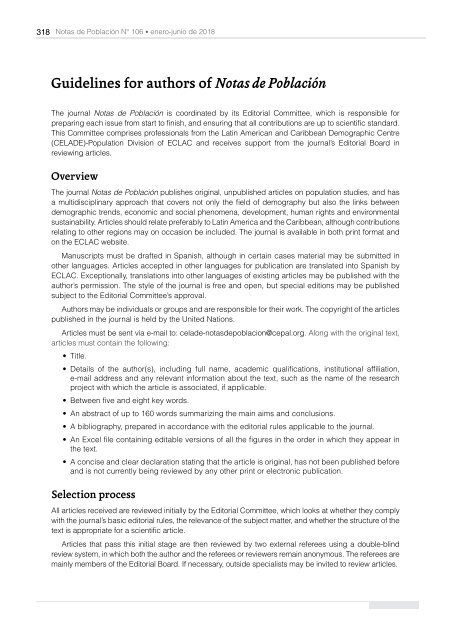Notas de Población N° 106
El número 106 de Notas de Población está conformado por 10 artículos, en cuya elaboración han participado 21 colaboradores. Los artículos abordan diversos temas de investigación relacionados con la mortalidad, el transnacionalismo migratorio y la fecundidad de las migrantes, así como la fecundidad adolescente, el femicidio, la migración de retorno, la segregación en el espacio urbano y el dividendo demográfico.
El número 106 de Notas de Población está conformado por 10 artículos, en cuya elaboración han participado 21 colaboradores. Los artículos abordan diversos temas de investigación relacionados con la mortalidad, el transnacionalismo migratorio y la fecundidad de las migrantes, así como la fecundidad adolescente, el femicidio, la migración de retorno, la segregación en el espacio urbano y el dividendo demográfico.
Create successful ePaper yourself
Turn your PDF publications into a flip-book with our unique Google optimized e-Paper software.
318 <strong>Notas</strong> <strong>de</strong> <strong>Población</strong> <strong>N°</strong> <strong>106</strong> • enero-junio <strong>de</strong> 2018<br />
Gui<strong>de</strong>lines for authors of <strong>Notas</strong> <strong>de</strong> <strong>Población</strong><br />
The journal <strong>Notas</strong> <strong>de</strong> <strong>Población</strong> is coordinated by its Editorial Committee, which is responsible for<br />
preparing each issue from start to finish, and ensuring that all contributions are up to scientific standard.<br />
This Committee comprises professionals from the Latin American and Caribbean Demographic Centre<br />
(CELADE)-Population Division of ECLAC and receives support from the journal’s Editorial Board in<br />
reviewing articles.<br />
Overview<br />
The journal <strong>Notas</strong> <strong>de</strong> <strong>Población</strong> publishes original, unpublished articles on population studies, and has<br />
a multidisciplinary approach that covers not only the field of <strong>de</strong>mography but also the links between<br />
<strong>de</strong>mographic trends, economic and social phenomena, <strong>de</strong>velopment, human rights and environmental<br />
sustainability. Articles should relate preferably to Latin America and the Caribbean, although contributions<br />
relating to other regions may on occasion be inclu<strong>de</strong>d. The journal is available in both print format and<br />
on the ECLAC website.<br />
Manuscripts must be drafted in Spanish, although in certain cases material may be submitted in<br />
other languages. Articles accepted in other languages for publication are translated into Spanish by<br />
ECLAC. Exceptionally, translations into other languages of existing articles may be published with the<br />
author’s permission. The style of the journal is free and open, but special editions may be published<br />
subject to the Editorial Committee’s approval.<br />
Authors may be individuals or groups and are responsible for their work. The copyright of the articles<br />
published in the journal is held by the United Nations.<br />
Articles must be sent via e-mail to: cela<strong>de</strong>-notas<strong>de</strong>poblacion@cepal.org. Along with the original text,<br />
articles must contain the following:<br />
• Title.<br />
• Details of the author(s), including full name, aca<strong>de</strong>mic qualifications, institutional affiliation,<br />
e-mail address and any relevant information about the text, such as the name of the research<br />
project with which the article is associated, if applicable.<br />
• Between five and eight key words.<br />
• An abstract of up to 160 words summarizing the main aims and conclusions.<br />
• A bibliography, prepared in accordance with the editorial rules applicable to the journal.<br />
• An Excel file containing editable versions of all the figures in the or<strong>de</strong>r in which they appear in<br />
the text.<br />
• A concise and clear <strong>de</strong>claration stating that the article is original, has not been published before<br />
and is not currently being reviewed by any other print or electronic publication.<br />
Selection process<br />
All articles received are reviewed initially by the Editorial Committee, which looks at whether they comply<br />
with the journal’s basic editorial rules, the relevance of the subject matter, and whether the structure of the<br />
text is appropriate for a scientific article.<br />
Articles that pass this initial stage are then reviewed by two external referees using a double-blind<br />
review system, in which both the author and the referees or reviewers remain anonymous. The referees are<br />
mainly members of the Editorial Board. If necessary, outsi<strong>de</strong> specialists may be invited to review articles.


















